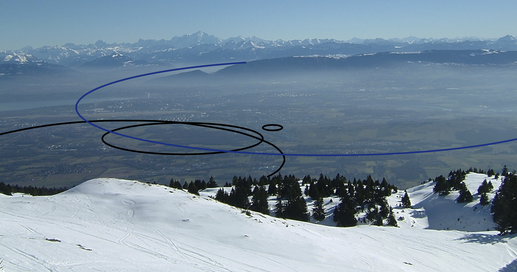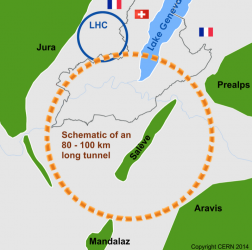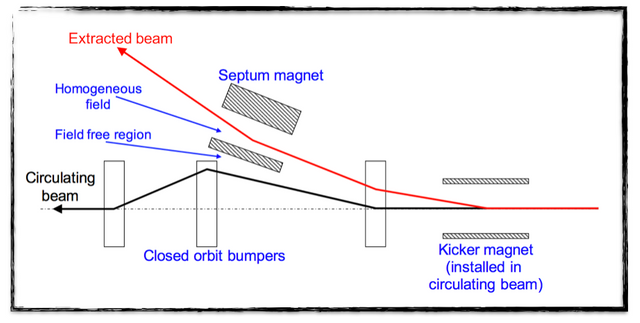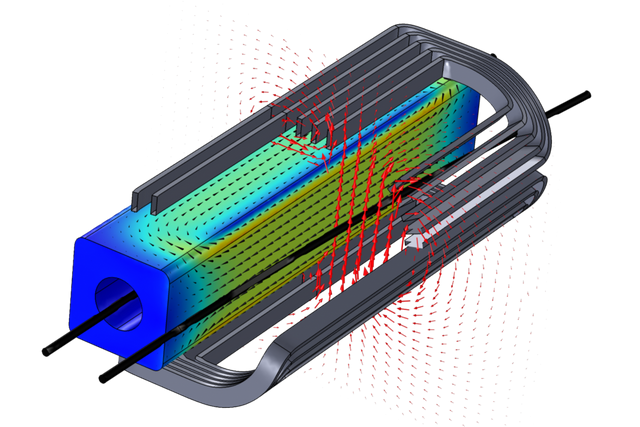Live from CERN - When sushis can help in the development of a future particle collider
I am very glad to finally have found the time to reinitiate my series of post ‘Live from CERN’. Everything comes with patience (the next item on my to-do list is to continue my quantum mechanics lecture series).
For those who where not there 3-4 months ago, in this ‘Live from CERN’ series of posts, I am discussing some fresh news about what is going on at CERN those days.
I decided today to discuss some developments targeting the future of CERN. An by future, I mean, the post-LHC era.
A FUTURE CIRCULAR COLLIDER

[image credits: FCC-ee @ CERN]
Long ago, I introduced on Steemit (in this post) one of the future options particle physicists could consider as a machine to be built after the LHC, in roughly 2035-2040
This option is called the FCC, an acronym that stands for a future circular collider.
This name actually speaks for itself. It is a machine to be built in 15-20 years from now, that will be circular and that will collide some particles.
Two possible sites are currently being discussed, one being at CERN, and the second one in China.
The CERN site is sketched on the above picture. One can notice a bunch of circles. Black circles are existing colliders, the big black circle being the LHC. The blue circle shows where the FCC tunnel would be.

[image credits: CERN]
The high-energy physics community is for the moment working on many different aspects of this project. One of them concerns the physics goals that could be reached at the FCC. I briefly presented some of my research work last week, here, discussing how the production of three Higgs bosons could help to understand better how nature works at the fundamental level.
There are also other on-going developments, in particular on the machine side.
HIGHLY-ENERGETIC BEAMS
The FCC machine is expected to collide very energetic particles. Whilst this may sound cool in terms of physics opportunities, this also consists of a challenge technologically speaking.
Focusing on the proton-proton collisions, the beams that will circulate in the accelerator will contain a huge amount of energy: 8.4 GJ, or 8.400.000.000 J. To make the picture clearer about what this number means, let us compare it to better known stuff.
8.4 GJ is twice the average annual energy usage of a fridge, or the energy released by the explosion of 2 tons of TNT. Please do not worry: we will not collide fridges…
This energy is really, really huge, and it is thus important to add protection systems to the machine so that one can safely take care of the beams in the event of a failure or at the end of an experimental run.
In other words, we need to be able to safely smash the beam into an absorber, or a beam dump, when one does need it anymore.
BEAM EXTRACTION
Beam extraction is achieved by making use of a two magnets, as illustrated by the picture on the left below.

[image credits: CAS 2009 school]
The first magnet, called the kicker magnet (right hand-side of the picture), has the simple task of kicking the beam into the second magnet by means of a fast-pulsed weak field.
The second magnet, called the septum magnet (middle-upper part of the picture), is instead slow-pulsed, but generates a very strong magnetic field that allows for the final deflection of the beam.
After having been deflected, the beam finally hits the external absorber.
The problem is that on the one hand, one needs a strong field in the septum magnet to deflect the beam to be extracted. On the other hand, the field outside cannot affect the circulating beam. It must hence be very weak
We thus need a sharp transition in space from a strong to a weak field that is very well located.
SUSHI TO EXTRACT PARTICLE BEAMS

[image credits: CERN]
The SuShi device is illustrated on the right.
The name is once again an acronym and stands for a Superconducting Shield septum magnet. This device is aiming for getting this sharp transition zone from a weak to a strong field in the septum magnet that I have mentioned above.
The idea relies on a passive superconducting shield that is required to create a zero-field zone inside the strong field in the septum.
This no-field zone is expected to be created by means of persistent induced Foucault (or Eddy) currents at the surface of the shield.
More precisely, the superconductor is cooled down in zero magnetic field. Then, when the superconductor will be exposed to a changing magnetic field, Foucault currents are induced on its surface in such a way that the change in the field is compensated (or at least tamed).
While usually, the resistivity of the conductors make the Foucault currents quickly decaying, superconductors have zero resistance so that Foucault currents have a very long lifetime of days or weeks.
The Foucault currents can hence be arranged to cancel the field where it needs to be canceled and during a long enough period.
And the technology works: SuShi prototypes are currently being tested at CERN and they do 2.5 times better than at the LHC.
TAKE-HOME MESSAGE AND REFERENCES
In this article, I describe one of the numerous technological developments that are being undertaken at CERN in the aim of maybe building, in a couple of decades, the next generation of particle colliders. I discussed some device that must be invented to be able to properly extract the beam when a danger occurs or when an experimental run is over.
SuShi is a piece of technology allowing to do it, accounting for the problem originating form the fact that the beams will be extremely energetic.
More information can be found v clicking on the following links:
SUSHI to extract particle beams... Too funny! Thanks for another excellent piece and for all the education it provides, as always. Namaste :)
It is never easy to find a good acronym. This time they made a very good job ^^
Fascinating post! And easy to read! Greatly appreciate you putting this post together and sharing it on SteemIt.
Have a great weekend!
Steem on,
Mike
Thanks a lot Mike! Have a great week-end too!
Very well written post! Always love hearing about CERN. 😊
Thanks a lot! It is always my pleasure to write about what is going on there :)
Very abstract details and very well presented :) YOu got yourself a new follower
Thanks a lot! :)
CERN did a lot of inventions... And has a great contribution in the modern science...recently scientists stores antimatter in the laboratory for nearly 17 seconds...If the scientists succeeds for storing it for long time then there will be no shortage of clean and environmental friendly energy in the world...
There are indeed a lot of antimatter experiments at CERN. I used to write a lot about them in the past (you can check my blog). I however do not understand how you may want to produce clean energy with antimatter. Do you mind detailing a little bit? Thanks in advance!
Hi there, I'm incredibly interested in the CERN artist residency COLLIDE and building my work to do the best application possible when ready! Following to keep your blog on my radar.
Thanks a lot. I remember this COLLIDE programme that was more or less in his first months of life starting when I was working at CERN. Art and science have a lot to talk with each other :)
Great post. I love anything CERN related. Smashing particles I'm a a book geek! I think Cern holds the 🔑 Key to a lot more of our few tech.
We have to develop ourselves some technologies for building our experiments. As a result, we are indeed releasing a lot of stuff free from any patent to the society. After all, that's the least we can do :D I really hope to see new discoveries during my career (I still have plenty of years in front of me ^^ )
Let me ask you a question. If they found a way to make us live longer with great quality of life Would you do it? I believe death is part of our journey.
I would do a few rounds in a virtual reality type of environment but if I could live an extra 30-40 years in great health I would do it. 🙂
I don't know whether this kind of things will be ever found at CERN. One the one hand, physicists are trying to understand how the universe works, etc..., which will probably have a very minor impact on the lives of most people. However, there are by-products that could be really really useful (medical accelerator or hadron-therapy to name two of those). This will not allow us to live forever, but this may improve our lives. And everything is public :)
If I would do it personally is probably a not relevant question, as I work on the first part (understanding how the universe works).
I am not sure I really answered the question... So, please let me know.
No, I understand what you mean but I read how Cern has found gluons the nuclear force that holds quarks. Then we have the God Particle, I feel these things can play a huge role in transhumanism and life extension. I know the question was a bit off the posts topic but I wanted to pick your brain a little! Your posts and responses are written in a very intelligent manner! Keep up the great work I enjoy reading them.
Actually, gluons were found for the first time elsewhere (in Hamburg, Germany). Other particles have been found at CERN, the last one being the Higgs boson at the LHC. The Higgs is sometimes called by the general audience the god particle although that has nothing to do with religion; the story about this naming is funny too: just an editor who changed a word in a title (goddamn to god).
I am kind of convinced elementary particles like the Higgs can play no role in any practical thing. it is first very hard to produce, and then it decays very quickly. I don't foresee how to store it for instance.
Thanks a lot for the chat. Don't hesitate to continue :)
The #CERN is such a great machine. I've been there a while ago and had the chance to go into the tunnel to visit the machine!
At the end of 2018 will happen the second long shutdown of the LHC. This will again be the time to go underground and visit the experiments :) Please let me know if you go there again in the future!
We went with a team from the #Cern IT depertment and I will see if they do this again. But it was not easy to get on this very limeted list
It is much easier with someone from the inside. Otherwise, you are stuck with the open-days periods.
Thank you for this wonderful post! I'm glad you decided to restart your series. I was starting to wonder what happened to them. I don't hear much anymore.
You're welcome!
I was away for 2-3 months because of my job who was really really demanding. Now the time is calmer and I have time to write again :)
Very good post! That would be so cool to see the collider in person.
The machine will be shut down for an upgrade after 2018. That will be the chance if you manage to come to CERN :)